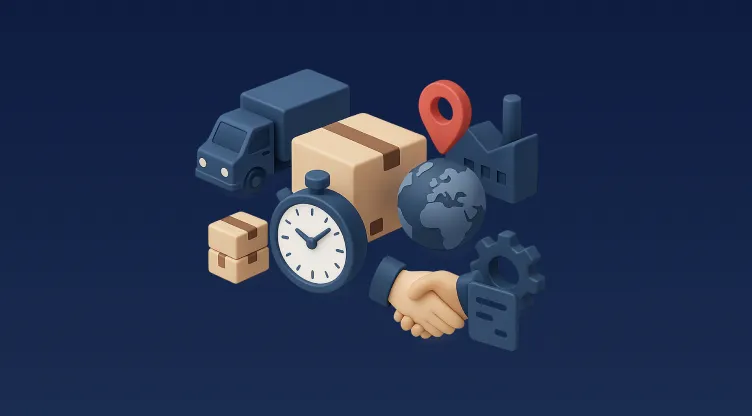Introduction
The world of e-commerce is evolving rapidly, and efficient order fulfillment is now a critical success factor for online retailers. Customers expect fast, reliable, and cost-effective delivery, making logistics a key competitive advantage.
A Transportation Management System (TMS) plays a crucial role in ensuring smooth e-commerce fulfillment by optimizing fleet operations and selecting the right logistics partners. But what is a transportation management system, and how can it help businesses improve delivery efficiency?
This guide will explore TMS in e-commerce, its role in fulfillment, and how to pick the right fleet and partners for online order deliveries.
What is a Transportation Management System (TMS)?
A Transportation Management System (TMS) is a software solution that helps businesses plan, execute, and optimize the movement of goods. It plays a vital role in automating logistics, reducing costs, and improving delivery efficiency.
Key Functions of a TMS in E-Commerce
- Route Optimization: Uses AI-powered algorithms to select the fastest and most cost-efficient routes.
- Fleet Management: Tracks vehicle availability, capacity, and utilization for better resource allocation.
- Carrier Selection: Compares multiple third-party logistics (3PL) providers to choose the best fit.
- Real-time Tracking: Enables customers and businesses to monitor orders in transit.
- Automated Dispatching: Allocates orders automatically to drivers based on delivery zones and vehicle capacity.
- Performance Analytics: Provides insights into on-time delivery rates, fuel usage, and fleet efficiency.
A TMS integrates with an Order Management System (OMS) and Warehouse Management System (WMS) to create a seamless e-commerce logistics operation.
Why is a TMS Essential for E-Commerce Fulfillment?
In e-commerce, timely and accurate delivery is everything. Customers expect same-day or next-day shipping, and managing thousands of orders without an automated system can lead to delays, errors, and high costs.
A TMS streamlines the fulfillment process by:
✅ Reducing Shipping Costs – Automatically assigns the most cost-efficient delivery method.
✅ Improving Delivery Speed – AI-powered route optimization ensures faster deliveries.
✅ Enhancing Customer Experience – Real-time order tracking and accurate ETAs improve customer satisfaction.
✅ Optimizing Last-Mile Delivery – Efficient fleet allocation ensures successful first-attempt deliveries.
✅ Minimizing Order Returns – Proper routing and coordination reduce misdeliveries and failed attempts.
How to Pick the Right Fleet for Online Order Deliveries
Selecting the right fleet for e-commerce fulfillment depends on factors like order volume, delivery zones, and customer expectations. There are three main types of fleets in e-commerce:
1. In-House Fleet (Owned by the Business)
Businesses operating at scale (e.g., Amazon, Noon, Carrefour) often manage their own fleet.
Pros:
✔️ More control over deliveries
✔️ Custom branding on vehicles
✔️ Direct customer communication
Cons:
❌ High operational costs (vehicle maintenance, fuel, drivers)
❌ Complex fleet management (requires a robust TMS)
2. Third-Party Logistics (3PL) Providers
Many e-commerce brands rely on external logistics partners like Aramex, DHL, Fetchr, and UPS to handle deliveries.
Pros:
✔️ No need to invest in a fleet
✔️ Scalable delivery operations
✔️ Access to extensive delivery networks
Cons:
❌ Less control over service quality
❌ Higher costs for peak-season deliveries
3. Hybrid Model (Combination of In-House & 3PL)
A hybrid approach combines both in-house and 3PL services, giving businesses flexibility and cost efficiency.
Pros:
✔️ Optimize costs by outsourcing low-priority deliveries
✔️ Use in-house fleet for high-priority shipments
✔️ Greater flexibility for peak seasons
Cons:
❌ Requires advanced TMS to manage multiple fleets
❌ More complex logistics coordination
Choosing the Right Logistics Partners
E-commerce businesses must evaluate logistics partners based on cost, reliability, and coverage. Here’s a step-by-step guide:
1. Evaluate Cost & Pricing Models
Compare shipping rates from different 3PL providers to determine the best cost-to-performance ratio. Some common pricing models include:
- Flat-rate shipping: Fixed fee per package
- Weight-based pricing: Charged based on package weight
- Distance-based pricing: Costs vary by delivery zone
2. Check Coverage & Delivery Speed
Select partners with a wide delivery network, especially in high-demand areas. For example:
- Aramex is strong in the MENA region.
- FedEx & UPS offer global shipping.
- Fetchr specializes in on-demand last-mile deliveries.
3. Assess Technology & Integration
Your TMS should integrate seamlessly with the 3PL’s systems to enable:
✅ Real-time order tracking
✅ Automated order dispatching
✅ Delivery status updates
4. Review Performance Metrics
Check their on-time delivery rates, success rate of first-attempt deliveries, and customer feedback.
5. Ensure Scalability
Can the 3PL handle peak-season demand? Choose flexible providers that offer scalable solutions.
How Omniful’s TMS Enhances E-Commerce Fulfillment
Omniful’s TMS is built for fast-growing e-commerce brands looking to automate fulfillment and scale delivery operations.
Key Features:
✅ Multi-Fleet Management – Manage in-house and outsourced fleets in one system.
✅ AI-Driven Route Optimization – Minimize delivery times and fuel costs.
✅ Seamless 3PL Integration – Connects with Aramex, FedEx, UPS, and local couriers.
✅ Real-Time Shipment Tracking – Live updates for customers and businesses.
✅ Fleet Capacity Optimization – Ensures maximum vehicle utilization.
With Omniful’s TMS, businesses can increase delivery efficiency, reduce costs, and improve customer satisfaction.
Conclusion
The success of e-commerce fulfillment depends on a well-managed transportation system. Choosing the right TMS, fleet, and logistics partners ensures faster deliveries, lower costs, and better customer experience.
A Transportation Management System (TMS) automates logistics, optimizes fleet operations, and integrates with 3PL providers for seamless order fulfillment. By selecting the right delivery model and partners, businesses can build a scalable and cost-effective logistics strategy.
Ready to Optimize Your E-Commerce Fulfillment?
🚀 Discover how Omniful’s TMS can transform your logistics and delivery operations! Contact us today for a demo.
FAQs
1. What is a Transportation Management System (TMS)?
A TMS is software that helps businesses plan, execute, and optimize logistics operations, ensuring cost-efficient and timely deliveries.
2. How does a TMS improve e-commerce fulfillment?
It automates fleet management, selects optimal routes, integrates with 3PL providers, and provides real-time tracking to enhance order fulfillment.
3. Should I use an in-house fleet or a 3PL for e-commerce deliveries?
It depends on cost, control, and scalability. A hybrid model (combining both) offers flexibility and efficiency.
4. How do I choose the best logistics partners?
Look at cost, delivery coverage, technology integration, performance metrics, and scalability.
5. How does Omniful’s TMS help businesses?
Omniful’s AI-driven TMS optimizes fleet operations, integrates with top logistics providers, and enhances last-mile deliveries.
























